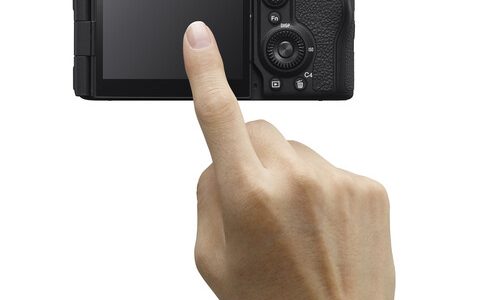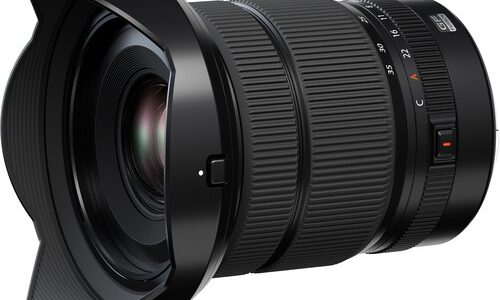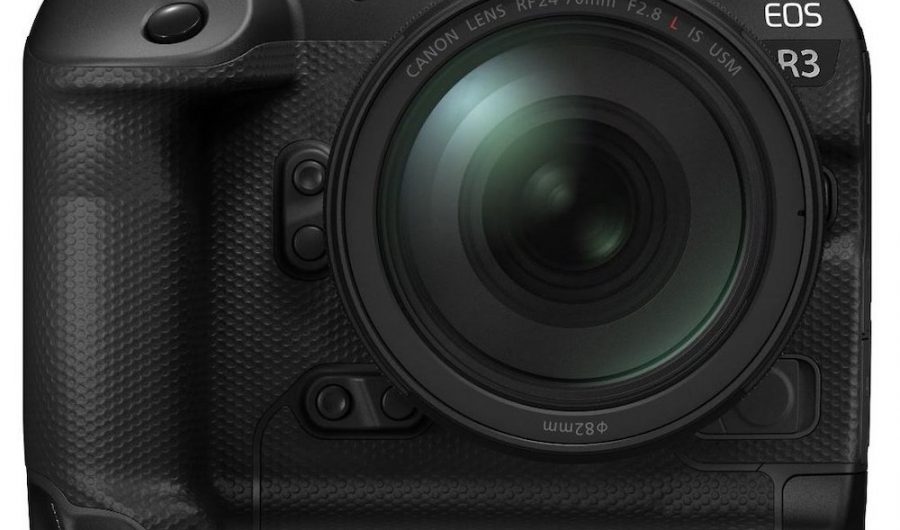

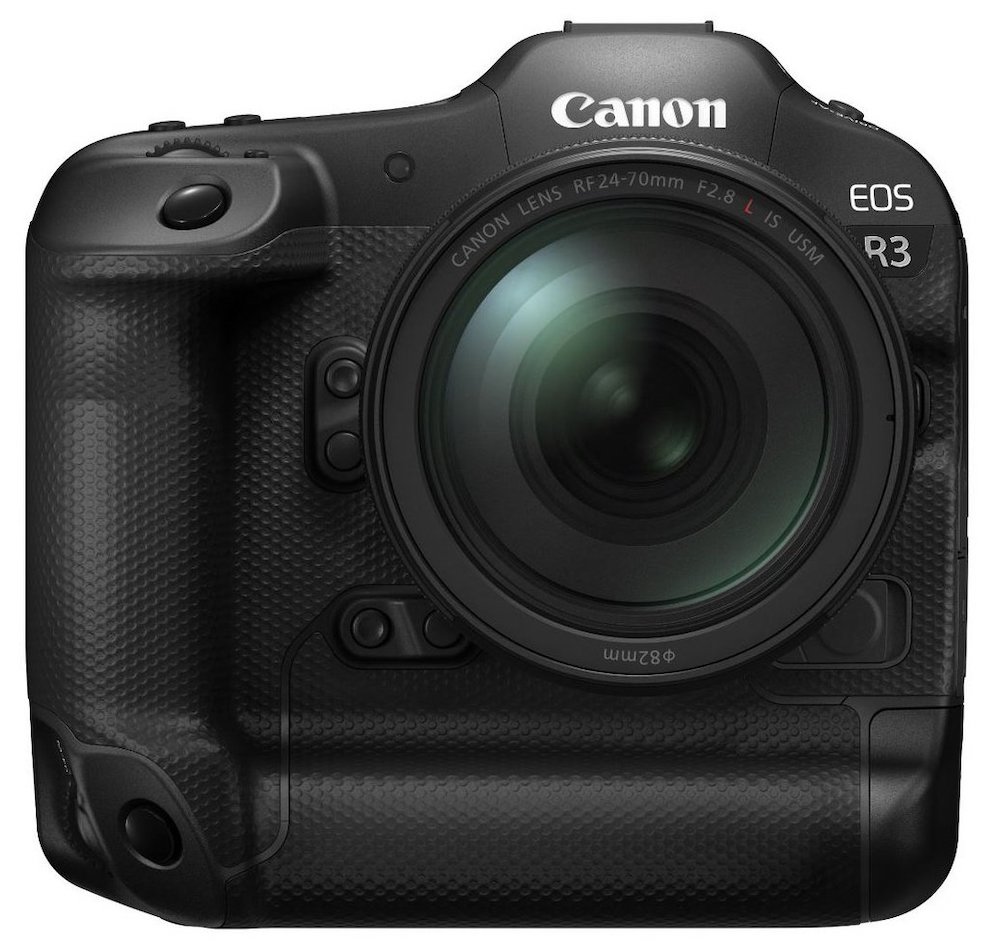
Perhaps due to the postponement of the Tokyo Olympics, the Big Three have all managed to at least pre-announce their new sports-oriented monsters in time that we are likely to see prototypes at the Games. On April 14, Canon joined the party with the development announcement of the new EOS-R3. We know a little bit about it, and we can speculate a bit more (based on measurements from pictures, what the competition is doing, and what the rumor sites are saying).
Interestingly enough, had the Tokyo Olympics taken place as originally scheduled, photojournalists would have been in quite a different position. There would have been no camera that combined resolution and speed in the way that the Sony A1, Nikon Z9 and presumably the new EOS-R3 do. Most of the coverage would have been with “speed” cameras – of which only the Sony A9 series was mirrorless. All three sports cameras would have been in the 20-24 MP range for stills, with only Canon offering any form of beyond-4K video. Canon and Nikon shooters would have been limited to DSLRs, with their inherent clunkiness for video use, relying exclusively on the rear screen in video modes. Someone might have gotten ahold of an EOS-R5, with an interesting combination of speed and resolution (there were a few floating around, mainly in the hands of Canon Explorers of Light, last July). Some photographers would have used Z7s and A7r IVs, both of which have excellent AF, but give up quite a bit of frame rate to a true sports camera. There were only two true sports mirrorless options, and one of them was the Olympus E-M1 line, limited by the Same Old Sensor.
Fast-forward by a year, and the Sony A1 is beginning to trickle into the wild (and should be relatively available by the Games). 50 MP, 8K video, super-fast AF and a 20 MP frame rate (30 with serious compromises). Nikon’s Z9 will probably show up in very limited quantity in time for the Games, perhaps only in the hands of Nikon Ambassadors, perhaps a little more widely than that? Now Canon is putting the R3 into the fray – at least Explorers of Light should have them, maybe a few more besides? The last major name out there is Fujifilm – are they going to do anything?
There really wasn’t a Sony alternative to Canon and Nikon’s big sports DSLRs at the time of the last Summer Olympics– nothing above the a6000 shot over 5 fps (the A9 wouldn’t appear until early 2017). Even if a Sony Artisan had a prototype A9, the only real lens options were the 70-200mm pair (f2.8 and f4) – the 400mm f2.8, the 600mm f4, the 200-600mm and even the 100-400mm are all more recent than that… The 300mm f2.8 still doesn’t exist (come on, Sony – Olympic track and field and swimming are naturals for that lens). Olympus was a much more natural choice than Sony for sports in 2016. There may have even been an Olympus Visionary or two using an (unannounced) E-M1 mk II in Rio – that camera would be announced the next month, and it looked enough like any other E-M1 that nobody would notice… A just-announced Fujifilm X-T2 would have been another semi-acceptable mirrorless possibility, although lenses would have been an issue (no 200mm f2). The 2016 Olympics were still a DSLR world – how far we’ve come in five years.
Interestingly enough, a Fujifilm shooter who simply brought an X-T4 (probably a bunch of them – although they could also rely on being able to buy more in Tokyo if one broke), a 200mm f2 and a couple of teleconverters to the 2020 Olympics would have a camera more capable in many ways than anything that showed up at the 2016 Olympics. It would give up a little bit in autofocus to a D5 or an EOS 1Dx mk II, but it would have a slightly faster frame rate, much better video (much better quality than Nikon, and Canon only shot 4K in horribly inefficient Motion JPEG at the time) and arguably better still image quality.
Even though the X-T4 is a more than acceptable choice for sports, Fujifilm could possibly introduce a dedicated sports (or combination sports/video) body this spring. Let’s call it an X-H2. It might be a little faster than an X-T4, although 15 fps with mechanical shutter and 20 fps electronic is already world-class. The X-T4 already shoots 400 mbps 4K60p video and 1080p at up to 240 fps – very little beats that, other than 8K and a few cameras with raw video modes. It could improve on the X-T4’s “good, but not great” AF. What it probably couldn’t do is shoot 40+ MP and 8K video like the Sony and Nikon (and probably the Canon). There is no known APS-C sensor with enough resolution – and if one were to appear, what other compromises might it make in image quality?
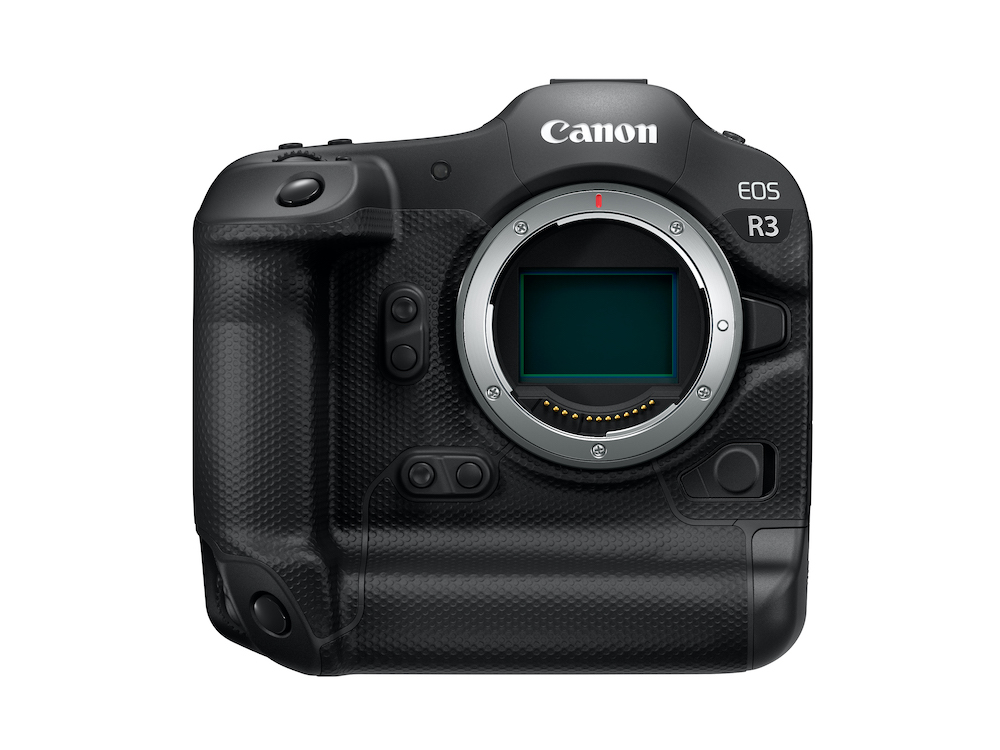
How nice of Canon – a picture with no lens lets us measure the sensor and the mount to get a better idea of the size of the body.
What do we know about Canon’s new sports beast? Like the Nikon Z9, and unlike the Sony A1, it is a dual-grip body. Sony has taken a different tack – the A1 is no bigger than an A9, and only marginally bigger than any modern A7 series body. Seemingly, and again like the Z9, it is significantly smaller than something like a 1Dx mk III or a D6. Depending on what you measure (lens filter threads, lens mount or image sensor), it appears to be between 140-150+mm wide. An EOS-1Dx mk III is 168mm wide. There’s at least half an inch, and possibly up to an inch in width (and a similar amount in height) difference between the two cameras. There is no way of judging the camera’s thickness, but it’s a decent bet that it might be thinner than a 1Dx mk III, since the lens mount has a much smaller flange distance. The Z9 and EOS-R3 appear to be defining a new camera size (the E-M1x was already sort of there, but that’s a rare camera indeed) – somewhere in the weight and overall size range of a midsize DSLR like a D850 or EOS 5D mk IV (although taller and less wide), but dual-gripped. It’ll be interesting to see how they handle.
The image sensor in the EOS-R3 is apparently all new. It is described as a completely new, Canon-developed, stacked, backside-illuminated design. This is intriguing, because Canon has never made a backside-illuminated sensor before. Essentially all modern non-Canon sensors are BSI designs, since Sony (who is involved in most other sensors) switched over a while ago. The two major exceptions in cameras Luminous readers might consider are the Same Old Sensor in Micro 4/3 cameras and the elderly 50 MP medium format sensor in the GFX 50 series and several Hasselblads. Canon has introduced two major technologies new to them here – not only is this a BSI design, it also has other components stacked with the sensor (like both generations of A9, the A1 and the Nikon Z9, as well as many, even most phone sensors). Since we’ve never seen a Canon BSI sensor, let alone one that is both BSI and stacked, this is the most “new and different” sensor in any interchangeable lens camera in years. It’s almost certainly the biggest change in Canon sensor technology in a single generation since the EOS-D30 way back in 2000 (that was a much larger change, as the first large CMOS sensor ever)! Until we see image samples, we have literally no idea how this thing performs.
With pretty much any other camera, we’ve had at least a good guess from other cameras using a similar sensor. Even if the exact sensor has never been seen before, there’s been some evidence from related sensors. The EOS-R5 was sort of an exception – it’s significantly different from anything else. Even that sensor was a new version of the technology Canon’s been using since the old EOS-D30. This is more like the kind of different sensors we saw all the time in the early days of digital photography, and occasionally since then. The first Sony BSI chip in an interchangeable-lens camera was in the A7r II way back in June of 2015, and “ everything’s Sony BSI” has been a not-bad generalization since. This sensor is perhaps even more of a shift for Canon than that one was for Sony, because it adds not only BSI, but also stacking, which Sony first did in 2017’s A9. What will it be like? We really have no idea, and we won’t until we see full-size raw files!
We do know that it features Canon’s excellent Dual-Pixel AF, along with a feature we haven’t seen since some of the later Canon film SLRs! Canon calls it “Eye Control AF” this time – just look at where you want the camera to focus, and it’ll follow your eye. Twenty years ago, they called it Eye Controlled Focus, but it disappeared from the early DSLRs, and it hasn’t been seen since. The EOS-D30 was based on a relatively low-level body, so it missed Eye Controlled Focus, and the EOS-1 series has never had it, whether film or digital. By the time DSLRs that were more equivalent to an EOS-A2 type body appeared, Eye Controlled Focus had long been history.
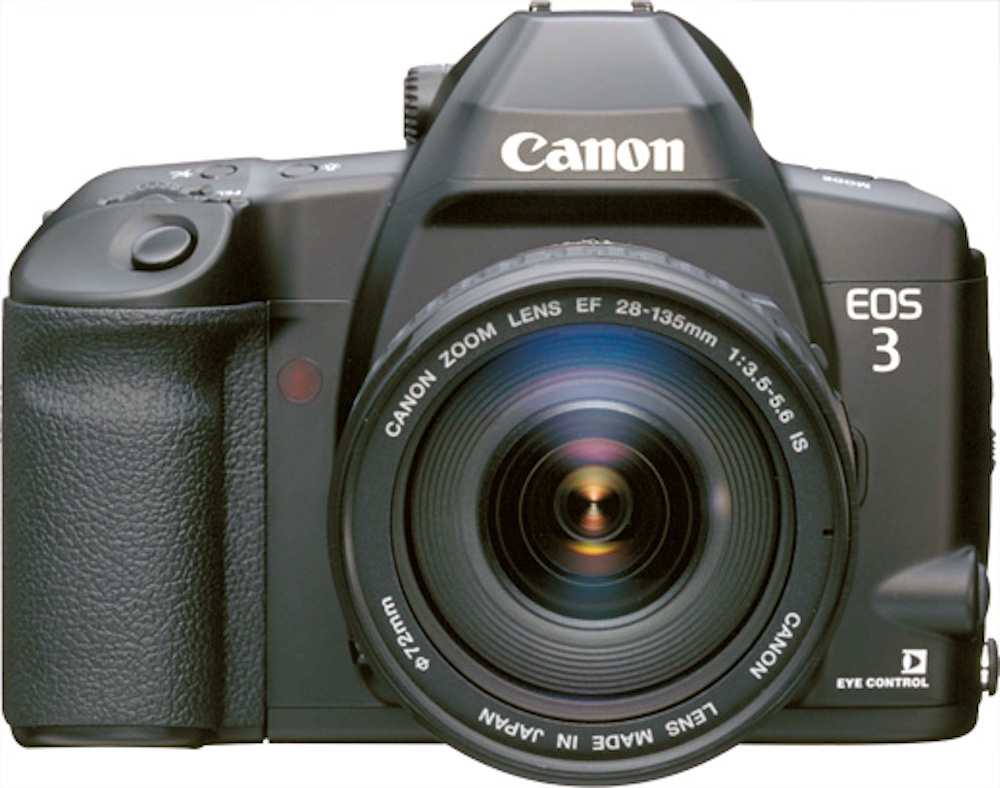
Well, it’s back… Twenty years ago, it was uncanny when it worked, but it was easily confused by glasses and glare. If they have it working really well, and working for most people, it could be the best solution yet to “how do I pick from hundreds or even thousands of AF points”. Repeatedly mashing buttons doesn’t work well, dials are a pain and touch screens are a sure way to get fingerprints on your monitor. Joysticks are by far the best idea so far, but even the best of them aren’t perfect (and I’m a little surprised nobody’s really tried either a touch pad or a trackball). If Canon gets Eye Control AF working really well, “just look your subject in the eye” is likely to be the best yet.
Canon has also let us know that the new sensor is extremely fast. They are claiming 30 fps (electronic shutter only – a mechanical shutter that fast would tear itself to pieces, movie camera shutters work completely differently) with full autoexposure and autofocus. That’s fast enough that it works (at least briefly) as a movie camera by shooting a sequence of stills – they don’t mention the buffer depth, so we don’t know how long it can keep that up. They are also claiming “much lower” rolling shutter effect, because of a very high readout speed.
There are many things we don’t know, starting with the resolution of the new sensor. Somewhere in the neighborhood of 45-50 MP would be a likely guess, but it’s only a guess. A couple of Canon-centered rumor sites claim to have information that points in that direction, but the sources are unclear. It makes logical sense with what competitors are doing – Sony’s A1 is known to be 50 MP, and Nikon’s Z9 is probably in the same range, since the 8K video Nikon has announced requires at least 40 MP and probably 45 MP (depending on how they define “8K”). The Nikon is unlikely to be hugely higher than that, because a massively higher resolution would require some real modifications for the 8K video. They could crop the sensor, which would cause complaints if it’s more than 1.1 or 1.2x. They could line-skip, which tends to produce softer video, or they could oversample, which would require huge processing power to oversample 8K. The most likely option is that the sensor is either exactly 8K wide (or almost exactly – the Z7 sensor is 8256 pixels wide, while cinema 8K is 8192 – that fits any reasonable definition of “almost exact”, and is my best prediction for the Z9) and crops only the top and bottom, or that it is modestly larger and crops the sides a bit.
Assuming that the EOS-R3 shoots 8K video (which is NOT confirmed from the tiny number of official specs), Canon faces exactly the same issue as Sony and Nikon. The only resolutions that make sense are in the 45-60 MP range – anything above that requires too much cropping (or line-skipping) for 8K video, until you get to around 100 MP, where oversampling starts to make sense (1.5:1 oversampling at 8K requires just about 100 MP). If Canon had not only reached 100 MP but also had a processor capable of oversampling video at that speed, I’d think they would be talking about it!
Probably the second most likely resolution for the EOS-R3 is in the 24-26 MP range. That’s the right resolution for 1.5:1 oversampled 4K video, although it doesn’t support 8K. It might record 6K (or something close) video, which a number of pro Canon DSLRs do. It’s also a very good resolution for most uses of sports photography, since 24 MP will go 20” wide at 300 dpi, allowing a double-page spread in a magazine with a little bit of cropping. There will be howls from one end of YouTube to the other if the EOS-R3 shows up with this relatively conservative resolution, but the pro sports photographers the camera is aimed at will be fine with it.
The third most likely resolution, although I think it’s unlikely, is actually 12 MP. It’s a perfect fit for 4K video, and it is enough for all but a few uses of sports photography – aside from a double-page spread, what requires more than 4000 pixels across? The first reason I think 12 MP is rather unlikely is that the initial marketing materials tout the R3 as a stills camera – a resolution that low is more fitting for a semi-dedicated video camera (Sony markets the A7s III primarily as a video camera that also shoots stills, for example). The second reason is that the R3 is also marketed as a wildlife photographers’ camera – they are making a big deal out of animal and bird-centric AF. 12 MP is too low for wildlife, both because wildlife photographers frequently sell prints, so a 300 dpi print size around 10×13” is limiting and because photographing wildlife often involves cropping. If it were a pure sports camera, 12 MP is almost acceptable (two-page spreads are still an issue), but it’s not enough for other likely uses…
Because of video, I think a resolution between about 60 MP (8K with a modest crop) and 100 MP (12K, 8K with oversampling) is quite unlikely. An 80 MP camera (for example) doesn’t really fit any obvious video resolution, and this isn’t a landscape-oriented camera where video might be a secondary consideration. Whatever the video modes are, they have to be excellent, and a resolution that makes that difficult is contraindicated. If Canon were able to go all the way to 100 MP, why would they hide a headline-grabber that big? I think 100 MP, while not absolutely impossible, is not only less likely than the logical 45-60 MP resolution, it’s also less likely than 24-26 MP, and even somewhat less likely than a very low resolution below 20 MP.
We know almost nothing about other features. Some things are logical – if it doesn’t have dual card slots, with at least one (and most likely both) supporting some flavor of CFExpress, I’ll be very surprised. It could be “standard” CFExpress Type B, as preferred by Nikon and used by Canon themselves on the R5, or it could be the tiny CFExpress Type A cards found on some recent Sonys. The body seems big enough to fit dual Type B slots, so that would be my hope. Similarly, if the viewfinder is not at least the 5.76 million dot unit found on the EOS-R5 and other cameras (if not the 9 million dot unit from Sony’s A7s III and A1), I’ll be surprised.
We haven’t heard about the battery at all, and there are three possibilities, one of which could come in either single or dual options. The first possibility is some variant on Canon’s venerable LP-E6 battery, probably the newest LP-E6NH that comes with the EOS-R5. It looks like the battery hatch puts the battery in the vertical grip area, similarly to most dual-grip cameras. If so, there should be room for two LP-E6NH batteries in there if Canon chooses to go that route. Two batteries would be 112mm long, and, even with the body tapering at the sides and a bit of room for a carrier, they’d probably fit. The second possibility is a version of the LP-E19 “big” battery from the EOS-1 series. The third possibility is a brand-new battery, which would almost certainly find its way into any EOS-R1 that is forthcoming above this camera. In case of anything other than the LP-E6, it would almost certainly be a single battery design – there’s no room for dual LP-E19s, and why design a new battery that is used in a dual configuration right away?
What will it be like? Well, we know less about this camera than about literally any other camera after its initial announcement in the past 20 years. It’s got a brand-new sensor that is almost certainly unrelated to anything on the market. It has a new body style that is in between several existing options, and the development announcement is very skimpy. It will almost certainly be extremely fast, with great autofocus – those features are highlighted in the announcement, and Canon has the experience to pull both off, rarely missing on either. Even though Canon hasn’t highlighted its color rendition, I would strongly expect it to be very pleasing – Canon has a well-deserved reputation in that department. Other than “extremely fast”, and “should have usual Canon strengths”, we know nothing at all. When there’s a camera that probably has a 3-5% chance of being 12 MP or so, as well as a 1-5% chance of being around 100 MP, that’s not really anything to go on.
If I had a concern, it would either be about dynamic range and noise characteristics (which Canon sensors have been getting better about, but have historically lagged behind Sony’s best by a stop or two), or about some unknown issue that crops up with the untested design. The EOS-R3 could easily end up as 2021’s Camera of the Year, but it could just as easily end up as a seriously compromised Version 1.0 product.
The other question raised by the development of an EOS-R3 is “what’s the R1 going to look like”? Canon hasn’t used the “3” designation in decades, but 1997’s EOS-3 was an extraordinarily innovative camera positioned just below the EOS-1N in the lineup. The biggest innovation (which not only did the contemporary EOS-1N not share, the EOS-1V a few years later didn’t, either) was the best version of Eye Controlled Focus – a 45 point system that worked for most people. The EOS-3 had most of the features of the later EOS-1V, although not the superlative build quality (you wouldn’t use an old 1-series EOS to pound tent pegs – for fear of bending the tent pegs…), plus the eye control the 1 series never got.
Canon claims this one has 1-series build quality and sealing, so they’re explicitly denying their old formula that a 3 is a 1 that isn’t built like a tank, plus a feature or two. They are explicitly saying that it’s positioned between the R5 and the 1Dx mk III, so there has to be something about it that will be eclipsed by the R1 when it arrives. I can’t really see how or why to make a still camera go faster than 30 fps (if you want faster than that, use a movie camera – just be careful to set the compression to something that fully records each frame) and they’re boasting about speed all over the place in the pre-announcement materials, so it seems unlikely that they are holding some speed back for the higher model.
The more I look at the promotional materials, the more suspicious I get that this might be a 24-26 MP camera. There’s no mention of 8K video with its attendant 40 MP minimum and there’s no mention of resolution (why not mention it if it’s at least as expected – Canon certainly knows what it is by this point). There’s actually no mention of image quality at all. A relatively low resolution would make the speed easier to achieve, and possibly make the brand-new sensor easier to fabricate? That certainly leaves plenty of room above it for the R1, either as a 45-50 MP camera or as something really high resolution.
Of course, it could also be a 45-50 MP camera – but the R1 is likely slated for 100 MP in that case…
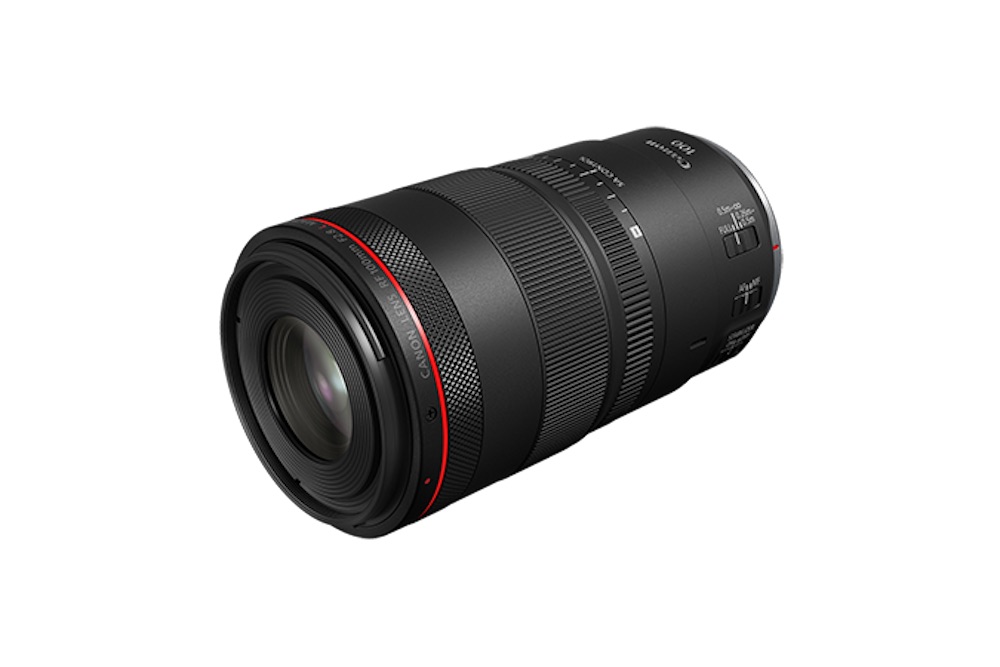
Canon also released three lenses on April 14, but only one of them is really a new lens. The actual new lens is the very innovative RF 100mm f2.8 L Macro IS USM. I am almost sure that this is the first autofocus lens to cross the 1:1 barrier (it focuses to 1.4x lifesize), and it is one of very few lenses to do that while also focusing to infinity. Most lenses capable of greater than 1:1 magnification don’t focus to infinity. Nikon, Sony and Fujifilm don’t presently list such lenses in their catalog (I’m almost sure Nikon used to make a few), while Canon has the 65mm MP-E that focuses from 1:1 to 5:1 (Canon claims it can fill the frame with a grain of rice).
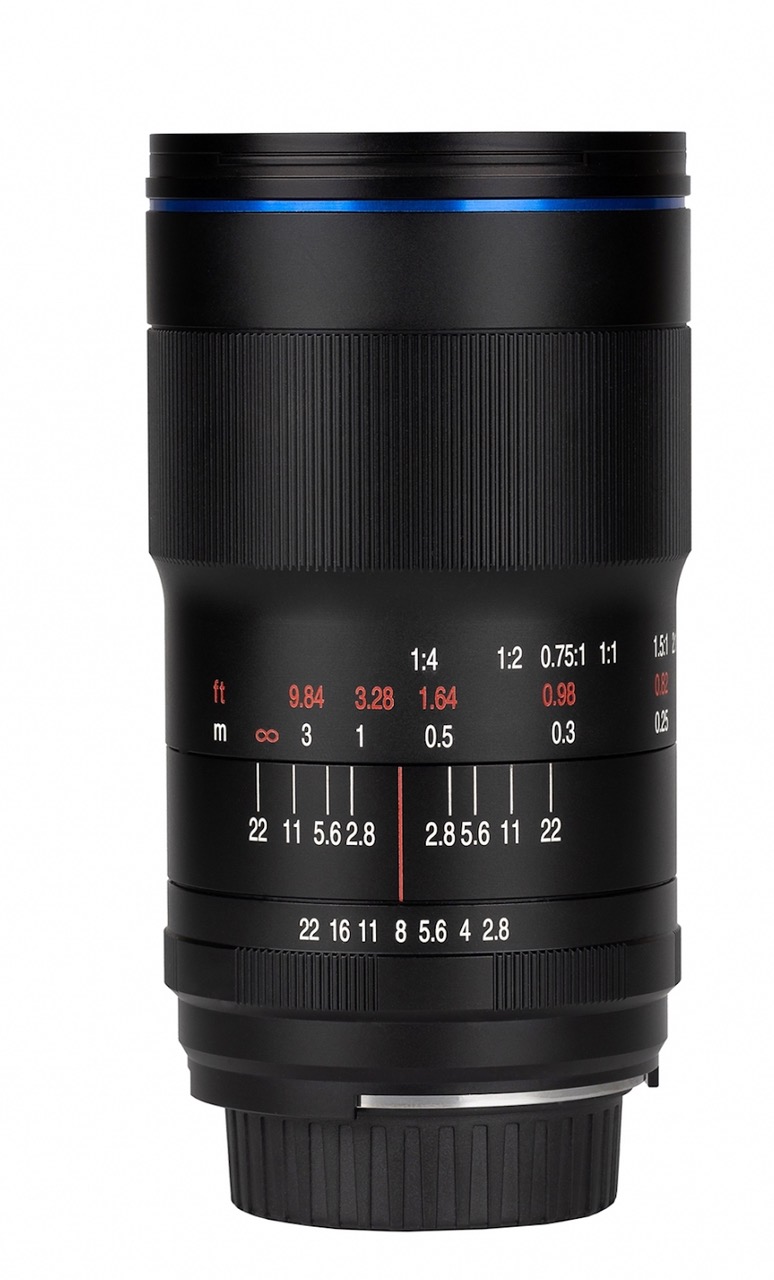
There are also a couple of relatively inexpensive Laowa manual focus lenses that go from infinity to 2:1, but these are typical “very aftermarket” (not the camera manufacturer, and not Sigma, Tamron, Tokina, etc. either) all-manual lenses with very limited electronic interfaces, and perhaps with limited quality control. I’ve never used a lens from one of the manual-only third parties but Roger Cicala at LensRentals has used quite a few Rokinons, and his remarks on quality control and build quality are worth reading – if you get a good one and treat it carefully, these “very aftermarket” lenses can be fine, sometimes better than that, but they go out of whack if you look at them wrong, and some weren’t any good to begin with.

Even if the new Canon 100mm macro lens were “just” a 100mm autofocus L-series macro for the RF mount that included image stabilization and happened to go from infinity to beyond lifesize, that’s already an interesting lens. It still has one more trick up its sleeve beyond that… It has what Canon’s calling spherical aberration control – an extra control ring that allows some control of the bokeh. I don’t really understand exactly what it does without having seen the lens, but it’s similar to Nikon’s defocus control portrait lenses.
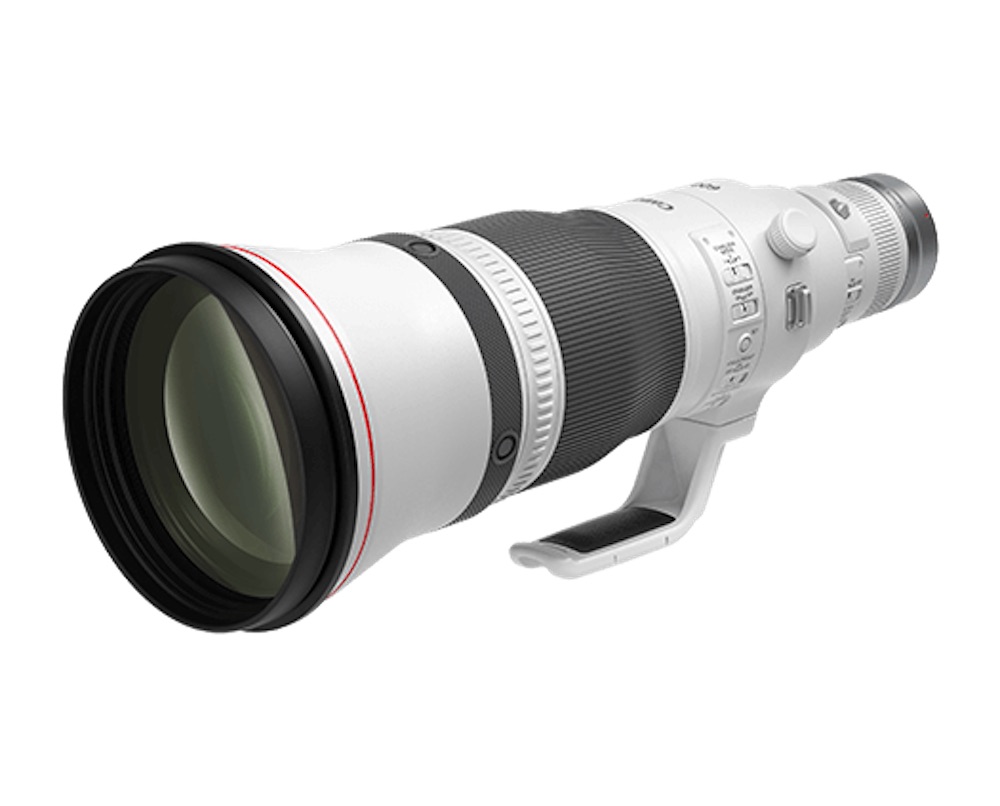
The remaining two lenses are “RF versions” of the existing Canon 400mm f2.8 and 600mm f4 L-series lenses. The important thing to remember is that RF versions of existing lenses is EXACTLY what they are – all Canon did is permanently mount an EF to RF adapter on the current lens. There is nothing optically or mechanically new about these lenses, and Canon could almost certainly offer a conversion service for a few hundred dollars, as Sigma does – whether or not they do is a marketing question. If you already own the EF lens, save yourself thousands of dollars and buy the $100 EF to EOS-R adapter (or the $200 version with an extra control ring) instead of a new lens.
If you’re in the market for one of these lenses, buy the EF variant if you might ever use it on a DSLR, and the RF variant if you’re sure that you’re committed to RF mount now and forever (one less thing to go wrong). They’re the same price, so there’s no reason not to buy the RF lens if you’ve sold your last EF DSLR. Fortunately, these are among the best lenses in the world, so you’re not losing anything from the quickie conversion. Why couldn’t Canon have done this years ago – it would take an engineering intern five minutes to figure out, even without looking at what Sigma already did when they brought a ton of Art lenses to mirrorless mounts (before launching the actually redesigned DG DN Art series). Could Canon have made the lenses more compact or even better optically by actually redesigning them? Possibly – there have been long telephotos on mirrorless that we never saw on DSLRs. On the other hand, long primes are excellent candidates for mount adapters – they don’t benefit as much from short flange distances as wide or very fast lenses. The permanent adapters eliminate one connection and point of failure. Oh, and Canon – please offer that conversion service. It’s a nice thing to do for people who own $12,000-$13,000 lenses…
Dan Wells
May 2021

Lorem ipsum dolor sit amet, consectetur adipiscing elit, sed do eiusmod tempor incididunt ut labore et dolore magna aliqua. Ut enim ad minim veniam, quis nostrud exercitation ullamco laboris nisi ut aliquip ex ea commodo consequat. Duis aute irure dolor in reprehenderit in voluptate velit esse cillum dolore eu fugiat nulla pariatur. Excepteur sint occaecat cupidatat non proident, sunt in culpa qui officia deserunt mollit anim id est laborum.
Lorem ipsum dolor sit amet, consectetur adipiscing elit, sed do eiusmod tempor incididunt ut labore et dolore magna aliqua. Ut enim ad minim veniam, quis nostrud exercitation ullamco laboris nisi ut aliquip ex ea commodo consequat. Duis aute irure dolor in reprehenderit in voluptate velit esse cillum dolore eu fugiat nulla pariatur. Excepteur sint occaecat cupidatat non proident, sunt in culpa qui officia deserunt mollit anim id est laborum.

Lorem ipsum dolor sit amet, consectetur adipiscing elit, sed do eiusmod tempor incididunt ut labore et dolore magna aliqua. Ut enim ad minim veniam, quis nostrud exercitation ullamco laboris nisi ut aliquip ex ea commodo consequat. Duis aute irure dolor in reprehenderit in voluptate velit esse cillum dolore eu fugiat nulla pariatur. Excepteur sint occaecat cupidatat non proident, sunt in culpa qui officia deserunt mollit anim id est laborum.
Lorem ipsum dolor sit amet, consectetur adipiscing elit, sed do eiusmod tempor incididunt ut labore et dolore magna aliqua. Ut enim ad minim veniam, quis nostrud exercitation ullamco laboris nisi ut aliquip ex ea commodo consequat. Duis aute irure dolor in reprehenderit in voluptate velit esse cillum dolore eu fugiat nulla pariatur. Excepteur sint occaecat cupidatat non proident, sunt in culpa qui officia deserunt mollit anim id est laborum.

Lorem ipsum dolor sit amet, consectetur adipiscing elit, sed do eiusmod tempor incididunt ut labore et dolore magna aliqua. Ut enim ad minim veniam, quis nostrud exercitation ullamco laboris nisi ut aliquip ex ea commodo consequat. Duis aute irure dolor in reprehenderit in voluptate velit esse cillum dolore eu fugiat nulla pariatur. Excepteur sint occaecat cupidatat non proident, sunt in culpa qui officia deserunt mollit anim id est laborum.

Lorem ipsum dolor sit amet, consectetur adipiscing elit, sed do eiusmod tempor incididunt ut labore et dolore magna aliqua. Ut enim ad minim veniam, quis nostrud exercitation ullamco laboris nisi ut aliquip ex ea commodo consequat. Duis aute irure dolor in reprehenderit in voluptate velit esse cillum dolore eu fugiat nulla pariatur. Excepteur sint occaecat cupidatat non proident, sunt in culpa qui officia deserunt mollit anim id est laborum.
Lorem ipsum dolor sit amet, consectetur adipiscing elit, sed do eiusmod tempor incididunt ut labore et dolore magna aliqua. Ut enim ad minim veniam, quis nostrud exercitation ullamco laboris nisi ut aliquip ex ea commodo consequat. Duis aute irure dolor in reprehenderit in voluptate velit esse cillum dolore eu fugiat nulla pariatur. Excepteur sint occaecat cupidatat non proident, sunt in culpa qui officia deserunt mollit anim id est laborum.
Lorem ipsum dolor sit amet, consectetur adipiscing elit, sed do eiusmod tempor incididunt ut labore et dolore magna aliqua. Ut enim ad minim veniam, quis nostrud exercitation ullamco laboris nisi ut aliquip ex ea commodo consequat. Duis aute irure dolor in reprehenderit in voluptate velit esse cillum dolore eu fugiat nulla pariatur. Excepteur sint occaecat cupidatat non proident, sunt in culpa qui officia deserunt mollit anim id est laborum.
Lorem ipsum dolor sit amet, consectetur adipiscing elit, sed do eiusmod tempor incididunt ut labore et dolore magna aliqua. Ut enim ad minim veniam, quis nostrud exercitation ullamco laboris nisi ut aliquip ex ea commodo consequat. Duis aute irure dolor in reprehenderit in voluptate velit esse cillum dolore eu fugiat nulla pariatur. Excepteur sint occaecat cupidatat non proident, sunt in culpa qui officia deserunt mollit anim id est laborum.

Lorem ipsum dolor sit amet, consectetur adipiscing elit, sed do eiusmod tempor incididunt ut labore et dolore magna aliqua. Ut enim ad minim veniam, quis nostrud exercitation ullamco laboris nisi ut aliquip ex ea commodo consequat. Duis aute irure dolor in reprehenderit in voluptate velit esse cillum dolore eu fugiat nulla pariatur. Excepteur sint occaecat cupidatat non proident, sunt in culpa qui officia deserunt mollit anim id est laborum.
Lorem ipsum dolor sit amet, consectetur adipiscing elit, sed do eiusmod tempor incididunt ut labore et dolore magna aliqua. Ut enim ad minim veniam, quis nostrud exercitation ullamco laboris nisi ut aliquip ex ea commodo consequat. Duis aute irure dolor in reprehenderit in voluptate velit esse cillum dolore eu fugiat nulla pariatur. Excepteur sint occaecat cupidatat non proident, sunt in culpa qui officia deserunt mollit anim id est laborum.
Lorem ipsum dolor sit amet, consectetur adipiscing elit, sed do eiusmod tempor incididunt ut labore et dolore magna aliqua. Ut enim ad minim veniam, quis nostrud exercitation ullamco laboris nisi ut aliquip ex ea commodo consequat. Duis aute irure dolor in reprehenderit in voluptate velit esse cillum dolore eu fugiat nulla pariatur. Excepteur sint occaecat cupidatat non proident, sunt in culpa qui officia deserunt mollit anim id est laborum.

Lorem ipsum dolor sit amet, consectetur adipiscing elit, sed do eiusmod tempor incididunt ut labore et dolore magna aliqua. Ut enim ad minim veniam, quis nostrud exercitation ullamco laboris nisi ut aliquip ex ea commodo consequat. Duis aute irure dolor in reprehenderit in voluptate velit esse cillum dolore eu fugiat nulla pariatur. Excepteur sint occaecat cupidatat non proident, sunt in culpa qui officia deserunt mollit anim id est laborum.
Lorem ipsum dolor sit amet, consectetur adipiscing elit, sed do eiusmod tempor incididunt ut labore et dolore magna aliqua. Ut enim ad minim veniam, quis nostrud exercitation ullamco laboris nisi ut aliquip ex ea commodo consequat. Duis aute irure dolor in reprehenderit in voluptate velit esse cillum dolore eu fugiat nulla pariatur. Excepteur sint occaecat cupidatat non proident, sunt in culpa qui officia deserunt mollit anim id est laborum.

Lorem ipsum dolor sit amet, consectetur adipiscing elit, sed do eiusmod tempor incididunt ut labore et dolore magna aliqua. Ut enim ad minim veniam, quis nostrud exercitation ullamco laboris nisi ut aliquip ex ea commodo consequat. Duis aute irure dolor in reprehenderit in voluptate velit esse cillum dolore eu fugiat nulla pariatur. Excepteur sint occaecat cupidatat non proident, sunt in culpa qui officia deserunt mollit anim id est laborum.
Lorem ipsum dolor sit amet, consectetur adipiscing elit, sed do eiusmod tempor incididunt ut labore et dolore magna aliqua. Ut enim ad minim veniam, quis nostrud exercitation ullamco laboris nisi ut aliquip ex ea commodo consequat. Duis aute irure dolor in reprehenderit in voluptate velit esse cillum dolore eu fugiat nulla pariatur. Excepteur sint occaecat cupidatat non proident, sunt in culpa qui officia deserunt mollit anim id est laborum.
Lorem ipsum dolor sit amet, consectetur adipiscing elit, sed do eiusmod tempor incididunt ut labore et dolore magna aliqua. Ut enim ad minim veniam, quis nostrud exercitation ullamco laboris nisi ut aliquip ex ea commodo consequat. Duis aute irure dolor in reprehenderit in voluptate velit esse cillum dolore eu fugiat nulla pariatur. Excepteur sint occaecat cupidatat non proident, sunt in culpa qui officia deserunt mollit anim id est laborum.
Lorem ipsum dolor sit amet, consectetur adipiscing elit, sed do eiusmod tempor incididunt ut labore et dolore magna aliqua. Ut enim ad minim veniam, quis nostrud exercitation ullamco laboris nisi ut aliquip ex ea commodo consequat. Duis aute irure dolor in reprehenderit in voluptate velit esse cillum dolore eu fugiat nulla pariatur. Excepteur sint occaecat cupidatat non proident, sunt in culpa qui officia deserunt mollit anim id est laborum.

Lorem ipsum dolor sit amet, consectetur adipiscing elit, sed do eiusmod tempor incididunt ut labore et dolore magna aliqua. Ut enim ad minim veniam, quis nostrud exercitation ullamco laboris nisi ut aliquip ex ea commodo consequat. Duis aute irure dolor in reprehenderit in voluptate velit esse cillum dolore eu fugiat nulla pariatur. Excepteur sint occaecat cupidatat non proident, sunt in culpa qui officia deserunt mollit anim id est laborum.
Lorem ipsum dolor sit amet, consectetur adipiscing elit, sed do eiusmod tempor incididunt ut labore et dolore magna aliqua. Ut enim ad minim veniam, quis nostrud exercitation ullamco laboris nisi ut aliquip ex ea commodo consequat. Duis aute irure dolor in reprehenderit in voluptate velit esse cillum dolore eu fugiat nulla pariatur. Excepteur sint occaecat cupidatat non proident, sunt in culpa qui officia deserunt mollit anim id est laborum.
Lorem ipsum dolor sit amet, consectetur adipiscing elit, sed do eiusmod tempor incididunt ut labore et dolore magna aliqua. Ut enim ad minim veniam, quis nostrud exercitation ullamco laboris nisi ut aliquip ex ea commodo consequat. Duis aute irure dolor in reprehenderit in voluptate velit esse cillum dolore eu fugiat nulla pariatur. Excepteur sint occaecat cupidatat non proident, sunt in culpa qui officia deserunt mollit anim id est laborum.
You May Also Enjoy...
Hand’s On: new Sony A9III and Sony 50mm G Master, Sony 85mm G Master, Sony 75-350mm APS lenses
A quick hands on look at Sony A9iii and the Sony APS 75-350mm len
The best wide-angle zoom in the world? The Fujinon G5 20-35mm f4 R WR reviewed.
FUJIFILM GF 20-35mm f/4 R WR L
